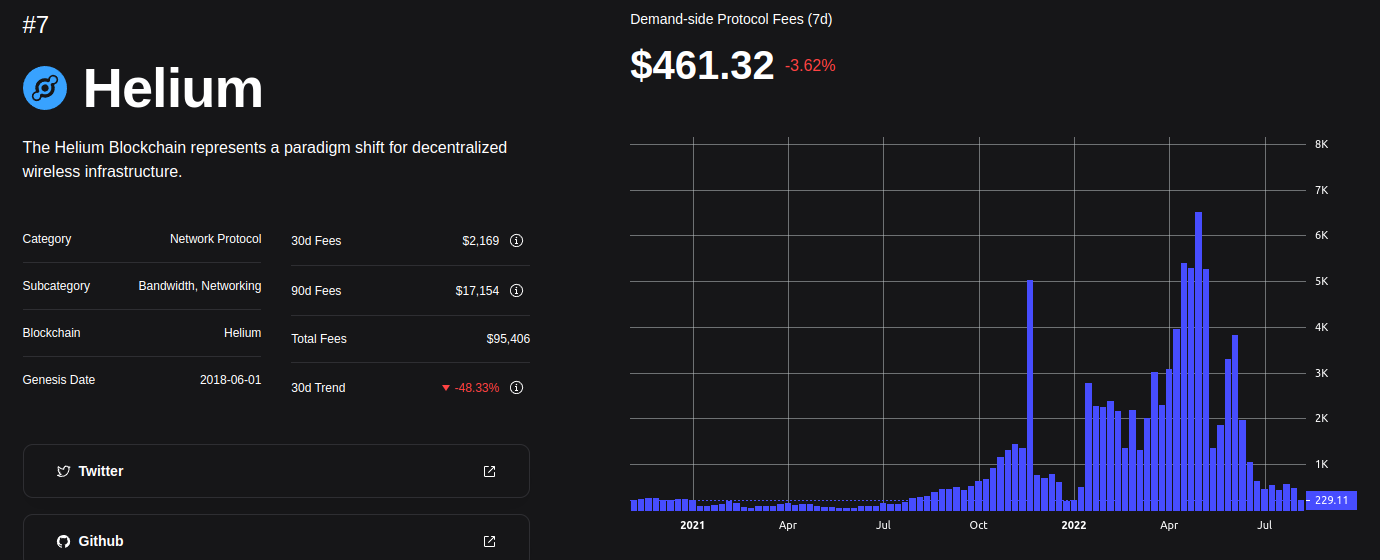Helium = Cypto + LoRaWAN Network
What is Helium?
Helium is a paid LoRaWAN network, to transmit data across the network you have to pay in Cryto currency. Its similar to The Things Network Enterprise that you have to pay but that is where the similarities end. Helium rewards people for installing gateways (the device that talks to LoRaWAN devices and passes the messages online to servers) with cypto curreny. This has caused a huge growth in people installing gateways at a rate of up to 80,000 a month.
We can see how much money is being made by transactions + fees on the network $1,892,816.66 as of today with 31,149 hotspots added (Data from) So this sounds great you have a LoRaWAN network that is growing rapidly and getting more and more coverage, all being funded by people transmitting data across the network right? Wrong.
Fees
To understand a little of what is going on here we need to understand the fee structure of Helium.
| Fee Type | Fee Description | Cost (DC) | Cost ($USD) |
|---|---|---|---|
| Send HNT | Transferring HNT from wallet to wallet | Variable |
Variable |
| Transferring Device Packet Data | Fee paid by device owner when sending or receiving sensor data. Metered per 24 bytes. | 1 |
$.00001 |
| Add Full Hotspot | Fee paid to add full Hotspot to the blockchain. Fee is generally covered by Hotspot maker. | 4000000 |
$40 |
| Add Data Only Hotspot | Fee paid to add a Data Only Hotspot to the blockchain. | 1000000 |
$10 |
| Assert Hotspot Location | Required when asserting a Hotspot’s location. (The first assertions is generaly covered by Hotspot maker) | 1000000 |
$10 |
| Assert Data Only Location | Required for Optionally asserting a Data Only Hotspot’s Location | 500000 |
$5 |
| Purchasing a blockchain OUI | Buy an OUI from the Helium blockchain | 10000000 |
$100 |
| Purchasing a blockchain Subnet | Buy a Subnet from the Helium blockchain | 10000000 |
$100 |
You can see that adding a new Hotspot/Gateway will cost DC so the more Hotspots added the more fee being generated. So for this month we have 31,149 Hotspots added with a fee of $40 so $1,245,960 for hotspots alone. So that is one side of the coin. The other is who is using it for a network to transmit data.
Data being transferred
So this is a big question as Helium does not make this number easy to find. So a third party has exposed the data (Link)

As we can see from this in the last 30 days the network has has $2,169 worth of transactions. This equates to 216,900,000 data transfer events. This number is extremely low for a growing network with so many nodes being added.
We can compare this with the stats for The Things Network (Link)
 We can see that in one week they did more data transfer events than the Helium Network did in a month. This is shocking!! We can also see that The Things Network only has 50,000 Hotspots. So this is really telling of how dead the Helium traffic is.
We can see that in one week they did more data transfer events than the Helium Network did in a month. This is shocking!! We can also see that The Things Network only has 50,000 Hotspots. So this is really telling of how dead the Helium traffic is.
If you want to know more about the hotspots and which ones are being used. (Good work to pull real traffic data from the Helium blockchain)
Conclusions
Looking at these statistics we can see things don’t look great. A large network has been built out but no one is using it. As negative as the post is I do believe there is a future for this network. I don’t personally use the network, my interest is more about LorWan the technology than the implementation but I do like this collision between Crypto and Network Coverage Incentivisation.
I think if the Helium network gets a significant user base of people passing messages it could become sustainable, but as it exists right now I don’t think the long term prospects look good. I also have to think about what the use cases are for a LorWAN network. They are not high bandwidth and Helium only allows one way communication (AFAICT). This reduces the use cases. I think the real use case of LorWAN is where people don’t have 5G/4G coverage, farms and forests. Far away locations, something the Helium network is not addressing.
So it will be interesting to see what happens from here.